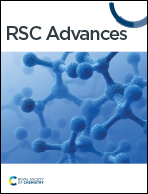Electrochemical detection of fluoride ions in water with nanoporous gold modified by a boronic acid terminated self-assembled monolayer
Abstract
Nanoporous gold (npAu) is a perfectly suited platform for the electrochemical detection of minor amounts of chemical species in solution due to its high surface-to-volume ratio. By surface-modification of the self-standing structure with a self-assembled monolayer (SAM) of 4-mercaptophenylboronic acid (MPBA) it was possible to create an electrode very sensitive towards fluoride ions in water, also suitable for mobile use in future sensing applications. The proposed detection strategy is based on the change in the charge state of the boronic acid functional groups of the monolayer, induced by fluoride binding. The surface potential of the modified npAu sample reacts fast and sensitively to stepwise F− addition, showing highly reproducible, well-defined potential steps with a detection limit of 0.2 mM. Deeper insight into the reaction of fluoride binding on the MPBA modified surface was gained by electrochemical impedance spectroscopy. The proposed fluoride sensitive electrode exhibits a favorable regenerability in alkaline media, which is of central importance for future applications considering environmental as well as economical aspects.



 Please wait while we load your content...
Please wait while we load your content...